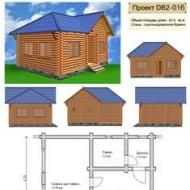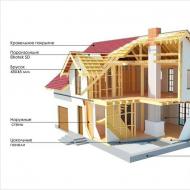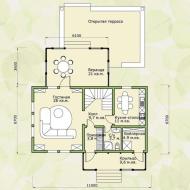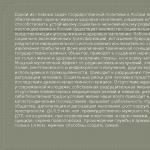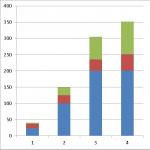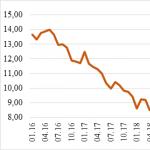
Kbk codes for paying taxes. How to find out kbk by inn organization and octmo. KBK for payment of penalties
KBK is a code budget classification. KBK codes for various taxes, including for 3-NDFL, can be found on the official website of the Federal Tax Service of Russia.
Method number 1. How to find out the KBK tax on the website nalog.ru
A list of KBK codes can be found in the section "Personal income tax" or directly at the link https://www.nalog.ru/rn01/taxation/kbk/fl/ndfl/.
Method number 2. How to find out the KBK tax using an online service
The KBK code can be found using the service https://service.nalog.ru/ This special service was developed on the site nalog.ru, with the help of it you can generate and print a receipt for paying tax. Since now in receipts for payment of tax, you need to indicate the BCC, using this service you can not only prepare a receipt, but also find out the BCC code, as well as the IFTS code and the OKTMO code of the tax inspectorate you are interested in.
On the first page of the service, you will be asked to enter data on the type of the payer and the type of payment document. Then click the "Next" button.
The payer can be an individual, an individual entrepreneur, the head of a farm or an individual engaged in private practice or a legal entity. The payment document can be used for cash payments when printed and submitted to the bank or for non-cash payments by electronic payment. A payment order can only be used for non-cash payments when printed and submitted to the bank.

Next, you need to select the type of payment. Since we do not know the BCC, and we just want to know it, we do not fill in this field, but first select the type and name of the payment, and then, if necessary, specify the type of payment. After that, the KBK will appear in the corresponding field automatically.

If the task is only to find out the KBK code, then, as you can see from the picture above, we have learned it. If there is a need to fill out a receipt, then you need to continue. As a result, you can print a receipt for payment in cash at the bank or immediately pay the tax in a non-cash way through various electronic services.
2018 Federal Tax Service classification codes for personal income tax (PIT)
182 1 01 02030 01 1000 110Personal income tax on income received by individuals in accordance with Article 228 of the Tax Code Russian Federation(payment amount (recalculations, arrears and arrears on the corresponding payment, including the canceled one)
182 1 01 02030 01 2100 110Personal income tax on income received by individuals in accordance with Article 228 of the Tax Code of the Russian Federation (penalty on the corresponding payment)
182 1 01 02030 01 2200 110Personal income tax on income received by individuals in accordance with Article 228 of the Tax Code of the Russian Federation (interest on the corresponding payment)
182 1 01 02030 01 3000 110Personal income tax on income received by individuals in accordance with Article 228 of the Tax Code of the Russian Federation (the amount of monetary penalties (fines) for the corresponding payment in accordance with the legislation of the Russian Federation)
182 1 01 02040 01 1000 110Personal income tax in the form of fixed advance payments on income received by individuals who are foreign citizens engaged in employment on the basis of a patent in accordance with Article 2271 Tax Code Of the Russian Federation (the amount of the payment (recalculations, arrears and arrears on the corresponding payment, including the canceled one)
182 1 01 02040 01 2100 110Personal income tax in the form of fixed advance payments on income received by individuals who are foreign citizens engaged in employment on the basis of a patent in accordance with Article 2271 of the Tax Code of the Russian Federation (penalty on the corresponding payment)
182 1 01 02040 01 2200 110Personal income tax in the form of fixed advance payments on income received by individuals who are foreign citizens engaged in employment on the basis of a patent in accordance with Article 2271 of the Tax Code of the Russian Federation (interest on the corresponding payment)
182 1 01 02040 01 3000 110Personal income tax in the form of fixed advance payments on income received by individuals who are foreign citizens engaged in employment on the basis of a patent in accordance with Article 2271 of the Tax Code of the Russian Federation (the amount of monetary penalties (fines) for the corresponding payment in accordance with the legislation Russian Federation)
The instruction on the application from January 1, 2005 of the new budget classification codes (BCC) was approved by Order of the Ministry of Finance of Russia No. 72n of August 27, 2004. And in accordance with the Ordinance of the Bank of Russia dated 25.08.04 No. 1493-U "On the peculiarities of using the formats of settlement documents when making electronic settlements through the settlement network of the Bank of Russia", the maximum length of field 104 of the settlement document has been increased to 20 characters.
KBK (field 104)- this is budget classification codes filled in field 104 of the payment order. For each type of tax in the payment order, its own budget classification code (BCC) is indicated. The maximum field length 104 (KBK) of the settlement document increased to 20 digits (characters).
The maximum number of KBK characters put down in the requisite 104 (field 104) is determined in the amount of 20, and this is indicated in Appendix 11 to the Regulation of the Bank of Russia dated June 19, 2012 N 383-P "On the rules for making a transfer Money".
And the very value of the BCC can always be clarified according to the Table of codes for the classification of budget revenues of the Russian Federation administered by the Federal tax service, which is given in the letter of the Federal Tax Service of the Russian Federation dated 16.12.2005 No. MM-6-10 / [email protected]
The structure of the code for the classification of budget revenues of the Russian Federation (KBK) consists of 20 categories, combined in 4 parts, and has the following form:
Let us consider the structure of the code of the budgetary classification of incomes (BCC) of the Russian Federation in more detail.
Part 1: 3-bit admin code
Administrator - occupies 1-3 digits of the BCC, consisting of three characters (symbols) and corresponding to the number assigned to the main manager in accordance with the list of the main managers of the corresponding budget.Administrators of budget receipts are:
- tax authorities;
- other government bodies;
- governing bodies of state off-budget funds;
- local government bodies;
- legal or individuals, authorized by the indicated state authorities, as well as state (municipal) institutions created by these authorities
- code of the Federal Tax Service of Russia - 182-0-00-00-000 ...;
- the code of the Federal Customs Service of Russia - 153-0-00-00-000 ...;
- RF Pension Fund code - 392-0-00-00-000 ...;
- Code of the Social Insurance Fund of the Russian Federation - 393-0-00-00-000 ...;
- Federal fund mandatory code health insurance- 394-0-00-00-000 ... etc.
Part 2: code of the type of income from 4 to 13 digits of the code for the classification of incomes of the budgets of the Russian Federation, which consists of 10 characters
Group - occupies the 4th category of the KBK (4th category of the code for the classification of budget revenues of the Russian Federation).The fourth category in the code of income types provides for the following groups:
- 000-1-00-00-000-00 ... - income;
- 000-2-00-00-000-00… - gratuitous transfers;
- 000-3-00-00-000-00… - income from entrepreneurial and other income-generating activities.
Subgroup - takes 5-6 digits of the KBK (5-6 digits of the code for the classification of budget revenues of the Russian Federation). Its filling depends on the group.
The group "Income" (000-1-00-00-000-00 ...) includes the following subgroups of the KBK:
- 000-1-01-00-000-00 - taxes on profits, income;
- 000-1-02-00-000-00 - taxes and social contributions;
- 000-1-03-00-000-00 - taxes on goods (works, services) sold in the territory of the Russian Federation;
- 000-1-04-00-000-00 - taxes on goods imported into the territory of the Russian Federation;
- 000-1-05-00-000-00 - taxes on total income;
- 000-1-06-00-000-00 - property taxes;
- 000-1-07-00-000-00 - taxes for the use of natural resources;
- 000-1-08-00-000-00 - state duty;
- 000-1-09-00-000-00 - debts for canceled taxes, fees and other obligatory payments;
- 000-1-10-00-000-00 - income from foreign economic activity;
- 000-1-11-00-000-00 - income from the use of state and municipal property;
- 000-1-12-00-000-00 - payments for the use of natural resources;
- 000-1-13-00-000-00 - income from the provision of paid services;
- 000-1-14-00-000-00 - income from the sale of tangible and intangible assets;
- 000-1-15-00-000-00 - administrative fees and charges;
- 000-1-16-00-000-00 - fines, sanctions, damages;
- 000-1-17-00-000-00 - other non-tax income;
- 000-1-18-00-000-00 - revenues of the budgets of the budgetary system of the Russian Federation from the return of the balances of subsidies and subventions of previous years;
- 000-1-19-00-000-00 - return of the balance of subsidies and subventions of previous years.
- 000-2-01-00-000-00 - gratuitous receipts from non-residents;
- 000-2-02-00-000-00 - gratuitous receipts from other budgets of the budgetary system of the Russian Federation, except for the budgets of state extra-budgetary funds;
- 000-2-03-00-000-00 - gratuitous receipts from state organizations;
- 000-2-05-00-000-00 - gratuitous receipts from supranational organizations;
- 000-2-07-00-000-00 - other gratuitous receipts.
- 000-3-01-00-000-00 - income from property from entrepreneurial and other income-generating activities;
- 000-3-02-00-000-00 - market sales of goods and services;
- 000-3-03-00-000-00 - gratuitous receipts from entrepreneurial and other income-generating activities;
- 00-3-04-00-000-00 - targeted deductions from state and municipal lotteries;
Subarticle - occupies 9-11 digits of the KBK (9-11 digits of the code for the classification of budget revenues of the Russian Federation), indicated in the settlement documents strictly in accordance with the values given in the classification of budget revenues of the Russian Federation.
Element - takes 12-13 digits of the KBK. In the 12th and 13th digits of the KBK, the code of the income element is indicated, which is fixed:
- For tax revenues, it is assigned to the level of the budgetary system of the Russian Federation, depending on the authority to establish tax:
- federal authorities;
- authorities of the constituent entities of the Russian Federation;
- authorities municipalities in accordance with the legislation of the Russian Federation on taxes and fees.
- For non-tax revenues, it is determined depending on the affiliation of the administrator of non-tax revenues to the budget to the corresponding levels of government.
- For gratuitous receipts, it is determined based on the ownership of the transfer to its recipient.
- 01 - federal budget;
- 02 - the budget of the constituent entity of the Russian Federation;
- 03 - local budget;
- 06 - Pension Fund Russian Federation;
- 07 - Social Insurance Fund of the Russian Federation;
- 08 - Federal Fund of Compulsory Medical Insurance;
- 09 - territorial compulsory health insurance funds.
Part 3: code of programs of budget revenues from 14 to 17 digits of the code of classification of budget revenues of the Russian Federation, i.e. 4-digit
Program - takes 14-17 categories of the KBK, which is used for separate accounting of the amounts of tax (collection), penalties and monetary penalties (fines) for this tax (collection). Budget revenue programs code (14 - 17 digits) consists of 4 characters.The classification of income programs is coded in four characters, of which the first character of the program code is used for separate accounting of the amounts of tax (collection), penalties, monetary penalties (fines) for this tax (collection), therefore, in the 14-17 digits of the KBK, the following should be indicated:
1000 - when paying taxes, fees, contributions (including recalculations, arrears and arrears);
2000 - penalties and interest on relevant taxes, fees, contributions;
3000 - the amount of monetary penalties (fines) for the relevant taxes, fees, contributions.
For example:
- KBK for income tax to the federal budget - 182-1-01-01-011-01-1000-110
- KBK for penalties on income tax to the federal budget - 182-1-01-01-011-01-2000-110
- KBK for a fine on income tax to the federal budget - 182-1-01-01-011-01-3000-110
Part 4: The economic classification of budget revenues is determined by a three-digit code for the classification of operations of the general government sector in accordance with Appendix No. 2 to the Decree of the Government of the Russian Federation of May 22, 2004. No. 249.
Economic classification - takes 18 - 20 bits of the KBK and has the following meanings:110 - tax revenues
120 - income from property;
130 - income from the provision of paid services;
140 - amounts of compulsory withdrawal;
150 - gratuitous and irrevocable income from budgets;
151 - receipts from other budgets of the budgetary system of the Russian Federation;
152 - transfers of supranational organizations and foreign governments;
153 - international transfers financial institutions;
160 - contributions, deductions for social needs;
170 - income from operations with assets;
171 - income from revaluation of assets;
172 - income from the sale of assets;
180 - other income;
410 - decrease in the value of fixed assets;
420 - decrease in the value of non-produced assets;
440 - decrease in the value of inventories.
When filling out field 104 "Budget classification code", the most common mistake is the indication in the 14th digit of the BCK zero value... Payments under such documents are directed by the Federal Treasury Department to the category of “unclassified” receipts. The fourteenth digit of the KBK is a symbol that is determined by the taxpayer, and cannot take the value "0" in settlement documents.
In addition to this material, information related to payment orders can be viewed on the website "
Every accountant in his work uses a budget classification code, how to find out the correct one - we'll talk in the article. A twenty-digit cipher allows you to identify a payment or receipt. The error can be fatal. Let's figure out which BCFs need to be indicated in 2020.
Application of budget classification ciphers determines the status economic entity... So, for example, individual entrepreneurs, commercial firms, and most NPOs in their activities use only tax codifications.
Tax BCCs are identifiers of fiscal obligations by their types, categories of taxpayers, taxable objects, and other characteristics. The BCC is indicated in the 104 field of the payment order, codification data are not reflected in accounting.
But the institutions of the budgetary sphere, in addition to the tax ciphers of the budget classification, also use income and expenditure in accounting. For state employees, each operation should be reflected not only in the corresponding accounting (budget) account, but also in the corresponding BCC.
For example, payout wages in a budgetary institution is reflected in the code 00000000000000000111, insurance premiums- 00000000000000000119, payment utilities- 00000000000000000244 and so on. State institutions are required to identify all symbols of the cipher. Moreover, not only numbers are used for identification, but also letters.
So what is KBK? This is a twenty-digit codifier that identifies a specific transaction - any cash flow in the budget system.
Important changes for state employees
Tax codes - how to find out
Timeliness and correctness of settlements with the Federal Tax Service is the guarantee of an accountant's peace of mind. Payments in budget system so much that you can get confused in no time. Moreover, one should remember not only the norms and rules of taxation in force in this year, but also relevant details for the transfer of taxes, fees and contributions.
We repeat that each tax payment has its own individual code. So, for example, for settlements with the Federal Tax Service in terms of the calculated VAT, you will have to indicate one code in the payment order, and in order to pay the accrued sanctions, another one, for example, the KBK of penalties.
In order not to get confused in payments, we offer an up-to-date KBK directory:
In the articles you will find not only the current codifications and can check the BCC for payment, but also check the correctness of the calculation of fiscal obligations.
All codes in one reference file
KBK by TIN
The question of how to find out the BSC of an organization by TIN does not have an adequate answer, but still it is asked with an enviable frequency. Let's figure it out.
The BC code is the transaction identifier, and the INN is the payer's identifier. So, the BC code in most cases has a constant value. For example, state-financed organization must pay VAT under the same codes as a commercial company or entrepreneur. But each taxpayer has its own TIN - a unique one. This means that there is no dependence between the indicated ciphers.
Budget classification codes are regulated by an order from the Ministry of Finance of the Russian Federation. The new version of the document, which was adopted in 2017, contains all the names of contributions and their corresponding values. All KBKs are divided into the following sections:
- taxes for legal entities and individual entrepreneurs for tax purposes (including personal income tax);
- tax payments for enterprises operating under special tax regimes;
- insurance premiums;
- payments for past periods;
- payments for new periods;
- classifier for fines and penalties;
- codes for making other tax deductions.
Payments to the pension and insurance fund also need to be supported by the codes of the budget classifier. The declaration is filled in by a tax agent, who is responsible to the fiscal authorities. It is worthwhile to carefully monitor the correctness of filling in all the lines, since an error will lead to a default on tax office... This state of affairs is fraught with the accrual of fines and other penalties.
What is the BCC for tax payments?
BCK (budget classification code) is a combination of numbers by which government bodies identify and group income, expenses and sources of the country's budget. The code is indicated on any accounting declaration that is subject to control. The use of certain combinations of numbers is based on the regulations of the Budget Code of the Russian Federation.
The need to use the KBK is to regulate relations between entrepreneurs and the state. Supporting payments with codes enables organizations to:
- have an official confirmation of the payments made;
- analyze the intended purpose of the payment;
- get rid of penalties in case of problems with the fiscal authorities.
Each company dealing with commercial activities, reports to the tax office, providing information on profits and expenses. The KBK can be figuratively called the state account. Due to the complex structure of receipts and losses of funds, it becomes necessary to create a large number of such “accounts”. In the process of contributing funds to the budget, an important role is also played by the oktmo, which makes it possible to determine the territorial affiliation of the municipality.
How to find out the BCC for payment of transport tax?
Individuals and legal entities pay transport taxes in accordance with the provisions of the Tax Code of the Russian Federation. For the official transfer of funds to the budget tax agent is obliged to enter the corresponding CSC in the declaration.
Many changes were made to the structure of the budget classifier codes in 2017, however, payments transport tax the reforms did not touch. You can find out the required code by using the order of the Ministry of Finance of the Russian Federation. The structure of the document is rather complicated for the perception of an inexperienced taxpayer. In connection with this difficulty, it was customary to create official explanations and regulations at the level of the Federal Tax Service. With the help of the explanations of the territorial fiscal authorities, you can easily find out the required code of the budget classifier.
All KBKs have a standardized length. Each of the twenty characters of the code corresponds to a specific parameter that allows you to identify the direction of the payment to the state budget. The structure of the combination of numbers consists of four blocks, each of which contains five characters.
How to find out the BCC for paying income tax?
All KBKs are regulated by an order issued by the Ministry of Finance of the Russian Federation. The use of codes is supported by certain articles of the Tax Code. You can also find out the code for paying tax on income from the operating activities of an enterprise from regulations and orders from local fiscal authorities, which are systematically issued and are of an explanatory nature.
The BCK for income tax payment consists of twenty symbols, which are divided into four sections. In each combination, certain information is encrypted, which is necessary for the identification of the payment.
The first three digits encrypt the data to determine government body... The fourth digit of the code is the name of the income group for which the tax is calculated. The next two symbols indicate the specifics of the payment. The next group numerically encrypts the meaning of the item and the sub-item of income.
- stock;
- regional;
- federal.
The next four numbers define the direction of the payment:
- payment of a fee or fee;
- payment of interest;
- payment of the penalty.
The last three numbers help determine the classification of the type of income. The complex use of combinations of these numbers makes it possible to carry out identification in automatic mode. The correct approach to the BCK analysis will help to correctly read the ciphers and determine the purpose of the payment.
How to find out the BCC for paying real estate tax?
Payment of real estate tax involves the use of a budget classifier code. The values of all BCF are contained in the order of the Ministry of Finance of the Russian Federation. For some individual entrepreneurs, it is quite difficult to work with such documents, so local fiscal authorities issue their own normative legal acts, which are of an explanatory nature.
The use of budget classifier codes is mandatory for all organizations engaged in commercial activities. The responsibility for the correctness of entering the codes in the declaration rests with the company's accountant. It should be borne in mind that errors in filling out the codes in the declaration can lead to arrears. The system will not be able to recognize the combination of numbers, so the payment will simply not reach the recipient.
The budget classification code is a combination of numbers that characterizes money transaction... it convenient way group budget revenues from organizations and individual entrepreneurs. On June 6, 2019, the Ministry of Finance published new KBK codes for penalties and fines for additional rates of insurance premiums. KBK from January 2020 are determined by order of the Ministry of Finance dated 06.06.2019 No. 86n. KBK on contributions for compulsory social insurance are specified in Appendix No. 1.
We will show you how to choose a code for transferring insurance premiums.
Pension contributions under normal working conditions
For insurance premiums at regular and reduced rates of pension contributions, a common code has been adopted. KBK for payments for employees for individual entrepreneur or for legal entity same. We indicate the following codes, filling in payment order, for crediting pension insurance contributions for periods from 2017:
Pension contributions for harmful, difficult and hazardous working conditions
With the splitting of these contributions in 2019, changes have occurred several times. Until January 1, 2019, the KBK for transferring interest and fines for additional contributions differed, taking into account whether the size of insurance rate from the carried out special assessment of labor. Since the beginning of 2019, this dependence has been removed, but returned starting from April 14, 2019, so it will remain in effect at the beginning of 2020. The BCC for payments is set for the entire list as a whole.
Additional pension contributions at tariff 1 ( p. 1 h. 1 tbsp. 30 of the Law of 28.12.2013 No. 400-FZ)
Additional pension contributions at tariff 2 (clauses 2-18, part 1 of article 30 of the Law of December 28, 2013 No. 400-FZ)
Contributions to the Health Insurance Fund and Social Insurance Fund for employees
The KBK 2020 for crediting funds to the FFOMS and FSS from the salaries of employees has not changed, the codes for maternity contributions have also remained the same, so we use the same codes as before. Let's recall them.
| Temporary disability and maternity contributions | |
| Contributions | 182 1 02 02090 07 1010 160 |
| Penalty | 182 1 02 02090 07 2110 160 |
| Penalties | 182 1 02 02090 07 3010 160 |
| Contributions to the FSS for injuries and occupational diseases | |
| Contributions | 393 1 02 02050 07 1000 160 |
| Penalty | 393 1 02 02050 07 2100 160 |
| Penalties | 393 1 02 02050 07 3000 160 |
| Contributions to the FFOMS for compulsory health insurance | |
| Contributions | 182 1 02 02101 08 1013 160 |
| Penalty | 182 1 02 02101 08 2013 160 |
| Penalties | 182 1 02 02101 08 3013 160 |
Individual entrepreneurs' contributions for themselves
If you do not employ hired labor, then you pay insurance premiums only for yourself. Now entrepreneurs pay all pension contributions for one BSC. The codes for crediting funds to the FFOMS and FSS have not changed, therefore we use the same codes as before.
note, IE pays insurance premiums, even if the entrepreneurial activity was not carried out.
| Pension insurance | |
| Contributions | 182 1 02 02140 06 1110 160 |
| Penalty | 182 1 02 02140 06 2110 160 |
| Penalties | 182 1 02 02140 06 3010 160 |
| Health insurance | |
| Contributions | 182 1 02 02103 08 1013 160 |
| Penalty | 182 1 02 02103 08 2013 160 |
| Penalties | 182 1 02 02103 08 3013 160 |
To transfer contributions in the amount of 1% of revenue exceeding RUB 300,000 per year, use the same code as for the fixed part - 182 1 02 02 140 06 1110 160.
Individual entrepreneurs can pay contributions for voluntary insurance in case of temporary disability and maternity according to KBK - 393-1-17-06020-07-6000-180. There are no penalties or penalties for them.
Transfer contributions in the Kontur.Accounting cloud service. The service will calculate contributions and personal income tax on its own, based on the salary, and generate payment orders, remind you of the due dates. Submit reports on employees, keep accounting, send reports from the service. Get the support of our experts, get rid of the rush and routine and work in the service for free for 14 days.



